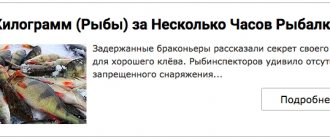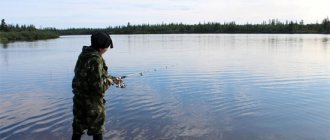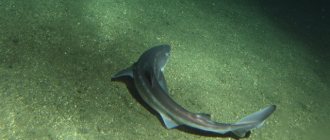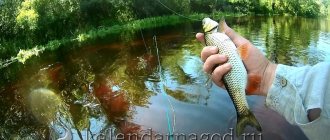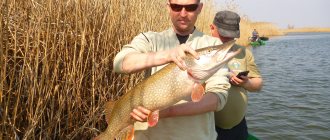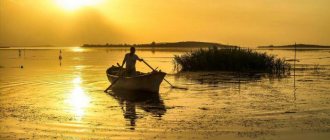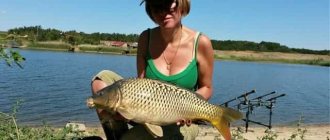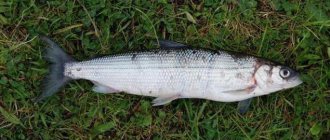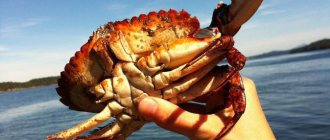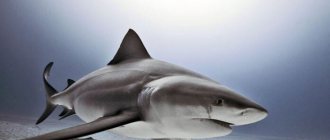Spring spawning ban in 2021 on reservoirs in the Republic of Crimea
It is worth noting that spawning bans are divided according to the type of reservoirs and their significance for the biological ecosystem of the region. So there are restrictions on fishing in the Republic of Crimea:
- From November 15 to March 31 - in wintering pits;
- From April 1 to May 31 in all inland water bodies of fishery importance of the Republic of Crimea (with the exception of chironomids (bloodworms) in water bodies in which industrial fishing of this species is permitted);
- from April 1 to August 31 - in the arms of estuaries and lakes connecting them to the sea, and in front of the arms from the sea and estuaries at a distance of less than 500 m in each direction, as well as less than 500 m deep into the sea, lake or estuary;
- Within the protected exclusion zones of hydraulic structures and bridges established in accordance with the legislation of the Russian Federation;
- On canals of spawning and rearing farms, with the exception of canals or parts thereof provided for the organization of amateur and sport fishing;
- In the Sea of Azov, the Kerch Strait and the Taganrog Bay - at a distance of more than 1.5 km from the coast.
Wintering pits of the Republic of Crimea
From November 15 to March 31 - in wintering pits, according to Order of the Ministry of Agriculture of Russia dated 06/09/2015 N 234, as well as amendments to the Order of the Ministry of Agriculture of Russia dated 01/09/2020 No. 1 “On approval of fishing rules for the Azov-Black Sea fishery basin” in water In objects of the Republic of Crimea of fishery importance, the extraction of biological resources is prohibited.
List of wintering pits in the Republic of Crimea:
| N p/p | Name | Location |
| 1 | Victorious | Pobednaya River: located from pumping station No. 1 to its confluence with Sivash Bay |
| 2 | Salgir | Salgir River: located from the administrative border of the village of Emelyanovka to its confluence with Sivash Bay |
| 3 | Kovrovo 1 | Irrigation system channel No. 2: located from the administrative border of the village of Kovrovo to the confluence with the Sivash Bay |
| 4 | Kovrovo 2 | Irrigation system channel No. 7: located from the administrative border of the village of Kovrovo to the confluence with the Sivash Bay |
| 5 | Nizhnegorskaya | bypass channel of pond No. 4 of the Nizhnegorsky fish farm (Republic of Crimea, Nizhnegorsky district, urban settlement of Nizhnegorsky) |
| 6 | Nekrasovka | discharge canal from the administrative border of the village of Nekrasovka, Sovetsky district to the confluence with the Sivash Bay |
| 7 | Dmitrovka | canal from the administrative border of the village of Dmitrovka, Sovetsky district, to the confluence with the Sivash Bay |
| 8 | Samarchik | Samarchik River from the junction with the Razdolnensky Canal to the confluence with the Karkinitsky Bay |
| 9 | Novorybatskaya | located in the watercourse connecting the ponds of the Crimean fish hatchery near the village of Novorybatskoye, Krasnoperekopsky district, with the Karkinitsky Bay |
| 10 | Chatyrlytskaya | Chatyrlyk River: located from the ponds of the Crimean fish hatchery upstream 3 km |
| 11 | Vorontsovskaya | Vorontsovka River: located from the ponds of the Crimean fish hatchery upstream 3 km; |
| 12 | Donuzlav | Lake Donuzlav: located from the Ablyamitsky bridge to the beacon in the area of the village of Novoozernoye |
| 13 | Sasyk | Lake Sasyk-Sivash: located 3 km on both sides of the bridge in the villages of Okhotnikovo and Garshino |
| 14 | Kizyl-Yar | Lake Kizyl-Yar: located 2 km from the bridge near the village of Ivanovka on both sides |
| 15 | Mizhgornaya | Intermountain Reservoir: located 200 m from the dam separating the Saki Canal |
| 16 | Simferopol | Simferopol Reservoir: located in the water area within the administrative boundaries of the village of Lozovoye |
From April 15 to June 15 , fishing for fish is prohibited (clause 47.11).
From January 1 to July 15 - crayfish in water bodies of the Republic of Crimea (clause 47.12).
From November 15 to March 31 - carry out spearfishing everywhere on inland water bodies (clause 47.14).
Throughout the year, barbel and brown trout (trout) in water bodies of fishery importance of the Republic of Crimea (clause 47.15).
From January 1 to May 31 - glossy flounder in the Sea of Azov, the Kerch Strait and Sivash Bay (paragraph 47.16).
From July 1 to July 31 - Black Sea shrimp in the Sea of Azov, the Kerch Strait and Sivash Bay (clause 47.17).
Throughout the year - pike perch and bersha in the Sea of Azov and in the Taganrog Bay (section 47.19).
From January 15 to February 28 (29) - pike in water bodies of fishery importance in the Republic of Crimea (clause 47.21). At this time she spawns.
From March 15 to April 30 - pike perch in water bodies of fishery importance of the Republic of Crimea (clause 47.22).
From March 15 to April 30 - rams and roaches in the Sea of Azov (section 47.25).
The Black Sea with the basins of the rivers of Crimea and the city of Sevastopol flowing into it, as well as the inland water bodies of Crimea and Sevastopol
Areas prohibited for the extraction (catch) of aquatic biological resources are established:
- in the rivers Psezuapse, Shah, Mzymta, Psou, their tributaries and at a distance of less than 1 km on both sides of their mouths;
- in front of river mouths at a distance of less than 500 m on both sides of the mouth;
Prohibited periods (periods) for the extraction (catch) of aquatic biological resources are established:
- from April 1 to May 31 - in all water bodies of fishery importance, except for the Vityazevsky Estuary and the Black Sea;
- from November 1 to February 28 - all types of aquatic biological resources in the following areas:
- in the waters of the Yalta cargo port of the city of Yalta at a distance from the shore of less than 100 m;
- in the water area of the Yalta passenger port and along the entire central Lenin embankment of the city of Yalta to the mouth of the Vodopadnaya River at a distance from the shore of less than 100 m;
- in the waters of the port of Artek at a distance from the shore of less than 100 m;
- in the Feodosia Gulf from the central pier of the city of Feodosia to the pier at Cape Chumka, inclusive, at a distance from the shore of less than 100 m;
- from the pier of the Karadag Nature Reserve to Cape Tolstoy inclusive at a distance from the shore of less than 100 m;
- from Cape Meganom to Cape Peshterny inclusive at a distance from the coast of less than 100 m;
- from August 20 to September 10 everywhere and from December 1 to April 30 in closed port waters - mullet (singil, mullet, sharpnose);
- from May 1 to June 15 - gobies in the sea;
- from February 14 to May 1 - glossy flounder in the sea (except Karkinitsky Bay) and in estuaries;
- from June 1 to August 31 - Black Sea shrimp, mussels ;
- from December 1 to April 30 - dark croaker and wolffish .
The types of aquatic biological resources prohibited for production (catch) are:
a) marine mammals, sturgeon species of fish, Black Sea salmon , light croaker , gurnard , female crayfish bearing eggs and larvae and any other aquatic animals and plants listed in the Red Book of the Russian Federation and the red books of the constituent entities of the Russian Federation in the area covered by this chapter of the Fishery Rules.
In the case of production (catch) of prohibited species of aquatic biological resources, they must be released into the natural habitat with the least damage, regardless of their condition.
Spawning ban 2021 in the Republic of Crimea and Sevastopol
Prohibited periods (periods) for the extraction (catch) of aquatic biological resources are established:
from April 1 to May 31 - in all water bodies of fishery importance, except for the Vityazevsky Estuary and the Black Sea;
from January 1 to July 15 - crayfish (freshwater crayfish);
from April 1 to August 31 - in the arms of estuaries and lakes connecting them to the sea, and in front of the arms from the sea and estuaries at a distance of less than 500 m in each direction, as well as less than 500 m deep into the sea, lake or estuary;
from November 1 to February 28 - all types of aquatic biological resources in the following areas:
- in the waters of the Yalta cargo port of the city of Yalta at a distance from the shore of less than 100 m;
- in the water area of the Yalta passenger port and along the entire central Lenin embankment of the city of Yalta to the mouth of the Vodopadnaya River at a distance from the shore of less than 100 m;
- in the waters of the port of Artek at a distance from the shore of less than 100 m;
- in the Feodosia Gulf from the central pier of the city of Feodosia to the pier at Cape Chumka, inclusive, at a distance from the shore of less than 100 m;
- from the pier of the Karadag Nature Reserve to Cape Tolstoy inclusive at a distance from the shore of less than 100 m;
- from Cape Meganom to Cape Peshterny inclusive at a distance from the coast of less than 100 m;
from August 20 to September 10 everywhere and from December 1 to April 30 in closed port waters - mullet (singil, mullet, sharpnose);
from May 1 to June 15 - gobies in the sea;
from February 14 to May 1 - glossy flounder in the sea (except Karkinitsky Bay) and in estuaries;
from June 1 to August 31 - Black Sea shrimp, mussels;
from January 15 to February 28 (29) - pike;
from December 1 to April 30 - dark croaker and wolffish.
The types of aquatic biological resources prohibited for production (catch) are:
- marine mammals, sturgeon species of fish, Black Sea salmon, light croaker, gurnard, female freshwater crayfish bearing eggs and larvae and any other aquatic animals and plants listed in the Red Book of the Russian Federation and the red books of the constituent entities of the Russian Federation in the area of application of this chapter of the Rules fisheries
In the case of production (catch) of prohibited species of aquatic biological resources, they must be released into the natural habitat with the least damage, regardless of their condition.
With regard to the minimum size of extracted (caught) aquatic biological resources (commercial size), the following requirements are established:
When carrying out recreational fishing, the irrevocable withdrawal of aquatic biological resources having a fresh length less than that specified in Table 20 (commercial size) is prohibited:
Name of aquatic biological resources / Length, cm
- Sudak 38
- Freshwater catfish 60
- Sazan 30
- Taran 16
- Rybets (cheese) 22
- Sinets 24
- Brown trout (freshwater resident form) 15
- White Cupid 45
- Barabulya 8.5
- Stavrida 10
- Bream 28
- Bersh 25
- Zherekh 35
- Silver carp 50
- Chekhon 24
- Black Sea-Azov herring, migratory and sea herring 17
- Pilengas 38
- Chub 28
- Flounder-kalkan 40
- Flounder glossa 17
- Sea ruff (scorpionfish) 15
- Pike 30
- Ide 26
- Bulls 10
- Lin 20
- Freshwater perch 15
- Mullet (singil, mullet, pointed nose) 20
- Mussels 5
- Crayfish (freshwater crayfish) 9
- Pusanok Azov 11
- Black Sea shrimp 3.5
- Mackerel 15
- Croaker dark 35
- Zubarik 26
The commercial size of aquatic biological resources is determined in fresh form:
- in fish - by measuring the length from the top of the snout (with the mouth closed) to the base of the middle rays of the caudal fin;
- in crustaceans - by measuring the body from the line connecting the middle of the eyes to the end of the tail plates;
- in mollusks (mussels and other bivalves) - by measuring the longest length of the shell.
Extracted (caught) aquatic biological resources having a length less than those indicated above are subject to immediate release into the natural habitat in a living form with the least damage.
The daily rate of production (catch) of aquatic biological resources (except for the case where such aquatic biological resources are subject to a permanent or temporary ban on production (catch) during recreational fishing) for one citizen during recreational fishing is indicated in the table below:
Name of aquatic biological resources / Daily rate of production (catch), kg/ind.
- Pike perch 2 copies
- Freshwater catfish 2 specimens
- Carp 3 copies
- Garfish 5 kg
- Ram 5 kg
- Rybets (cheese) 5 copies
- White Cupid 2 copies
- Brown trout (freshwater resident form) 5 specimens
- Red mullet 5 kg
- Horse mackerel 10 kg
- Asp 3 copies
- Silver carp 2 copies
- Black Sea-Azov herring, migratory and sea herring 5 kg
- Pilengas 10 kg or 6 copies
- Flounder-kalkan 7.5 kg or 2 copies
- Flounder glossa 5 kg
- Sea ruff (scorpion fish) 5 kg
- Dark croaker 5 kg or 3 copies
- Steers 5 kg
- Mullet (singil, mullet, pointed nose) 15 copies or 7.5 kg
- Mackerel 5 kg
- Pelamida 5 kg or 3 copies
- Mussels 5 kg
- Rapana 30 kg
- Crayfish (freshwater crayfish) 30 copies
- Black Sea shrimp 2 kg
- Artemia (including at the cyst stage) 0.2 kg
- Chironomids 0.5 kg
- Polychaetes 0.5 kg
- Chub 20 copies
- Atherina 10 kg
- Zubarik 3 kg
- Sea crucian carp 5 kg
- Merlang 10 kg
- Katran shark 5 kg
- Sea fox stingray 5 kg
- Stingray stingray 5 kg
- Sardine 5 kg
- Hamsa 10 kg
- Sprat (sprat) 10 kg
- Tulka 5 kg
- Sea burbot 5 kg
- Solnechnik 5 kg
- Lavrak 10 kg
- Bluefish 10 kg
- Smarida 5 kg
- Silver crucian carp 10 kg
The total daily rate of production (catch) of all types of aquatic biological resources (except rapana) indicated in the table above is no more than 10 kg or 1 specimen if its weight exceeds 10 kg.
Extraction (catch) of aquatic biological resources is permitted in the amount of no more than one daily norm when staying on a water body for one day. In case of stay on a water body for more than 1 day, regardless of the time of stay on the water body, production (catch) of aquatic biological resources is permitted in the amount of no more than 2 daily production (catch) norms.
If the daily norm is exceeded, production (catch) of all types of aquatic biological resources permitted for production (catch) is stopped.
Minimum size of fish allowed to be caught in the Republic of Crimea
Minimum size of fish allowed for seizure during recreational fishing in the territory of the Republic of Crimea:
| Name of aquatic biological resources | Length, cm |
| Pike perch in other water bodies of fishery importance | 38 |
| Freshwater catfish | 60 |
| Carp | 35 |
| Carp | 24 |
| Taran | 16 |
| Rybets, raw | 22 |
| Sinets | 24 |
| white cupid | 45 |
| Bream in the Don River | 28 |
| Bream in other freshwater bodies of fishery importance | 24 |
| Bream in the Tsimlyansk Reservoir | 27 |
| Brown trout (freshwater resident form) | 15 |
| Barbels | 20 |
| Podust | 15 |
| Bersh | 26 |
| Asp | 35 |
| Silver carps | 50 |
| Chekhon | 24 |
| Black Sea-Azov herring, migratory and sea herring | 15 |
| Pilengas | 38 |
| Chub | 28 |
| Tench | 17 |
| Pike | 30 |
| Ide | 26 |
| Gobies | 10 |
| Crayfish (freshwater crayfish) | 9 |
| Crayfish (freshwater crayfish) in the Tsimlyansk Reservoir | 10 |
| Flounder glossa | 17 |
| Mullet (singil, mullet, pointed nose) | 20 |
| Horse mackerel | 10 |
clause 50.5. The total daily production (catch) rate for all types of aquatic biological resources (except for rapana and crucian carp) indicated in Table 2 is no more than 5 kg or 1 specimen if its weight exceeds 5 kg.
Extraction (catch) of aquatic biological resources is permitted in an amount of no more than 1 daily norm when staying on a water body for 1 day. In case of stay on a water body for more than 1 day, regardless of the time of stay on the water body, production (catch) of aquatic biological resources is permitted in the amount of no more than 2 daily production (catch) norms.
If the daily norm is exceeded, production (catch) of all types of aquatic biological resources permitted for production (catch) is stopped.
Where, when and what kind of fish will be banned from catching off the coast of Crimea in 2021
The Border Department of the FSB of the Russian Federation for Crimea informs the population about the upcoming temporary bans on fishing for aquatic biological resources in the Black Sea in 2021.
“In order to preserve and increase the population of aquatic biological resources, a number of temporary restrictions will apply in the Black Sea waters prohibiting recreational and sport fishing,” the department’s press service said in a statement.
Fishing will be prohibited:
- from February 14 to May 1 - glossy flounder in the sea (except Karkinitsky Bay) and in estuaries;
- from April 1 to August 31 - in the arms of estuaries and lakes connecting them to the sea, and in front of the arms from the sea and estuaries at a distance of at least 500 meters in each direction, as well as less than 500 meters deep into the sea, lake and estuary;
- from May 1 to June 15 – gobies in the sea;
- from June 1 to August 31 – Black Sea shrimp (stone and grass), mussels.
- from August 20 to September 10 – mullet (singil, mullet, sharpnose).
From November 1, 2021 to February 28, 2021
Fishing for all types of FBR is prohibited in the following areas:
- in the water area of the Yalta sea trade port to the mouth of the Vodopadnaya River in Yalta at a distance from the shore of less than 100 meters;
- in the waters of the Yalta sea passenger port and along the entire central embankment of Yalta at a distance from the shore of less than 100 m;
- in the waters of the port of Artek at a distance from the shore of less than 100 m;
- in the Gulf of Feodosia from the central pier of Feodosia to the pier at Cape Chumka, inclusive, at a distance from the shore of less than 100 m;
- from the pier of the Karadag Nature Reserve to Cape Tolstoy inclusive at a distance from the shore of less than 100 m;
- from Cape Meganom to Cape Peshterny inclusive at a distance from the coast of less than 100 m.
During the specified period of time and in the places where the ban was introduced, raids will be carried out as part of interdepartmental groups of the border control, the Ministry of Internal Affairs, the Federal Fisheries Agency, the National Guard and district administrations. For violation of the law, the perpetrators will bear administrative liability under Part 2 of Article 8.17 and Part 2 of Article 8.37 of the Code of Administrative Offenses of the Russian Federation. The sanctions of these articles provide for large fines and confiscation of the vessel and other instruments for committing the offense.
For large and especially large damage, the perpetrators may be held criminally liable, in accordance with Article 256 of the Criminal Code of the Russian Federation - illegal extraction (catch) of aquatic biological resources. Damage exceeding one hundred thousand rubles is considered major, and especially large – two hundred and fifty thousand rubles.
Interested citizens are recommended to study Section IV of the Fishery Rules for the Azov-Black Sea fishery basin, approved by Order of the Ministry of Agriculture of the Russian Federation dated August 1, 2013 No. 293.
Border guards ask fishermen to be understanding of these time restrictions.
Daily catch rate for 2021 in the Republic of Crimea
| Name of aquatic biological resources | Daily rate of production (catch), kg/individual. |
| Zander | 2 copies |
| Freshwater catfish | 2 copies |
| Carp | 3 copies |
| Garfish | 5 kg |
| Taran | 5 kg |
| Rybets (cheese) | 5 copies |
| white cupid | 2 copies |
| Brown trout (freshwater resident form) | 5 copies |
| Barabulya | 5 kg |
| Horse mackerel | 10 kg |
| Asp | 3 copies |
| Silver carps | 2 copies |
| Black Sea-Azov herring, migratory and sea herring | 5 kg |
| Pilengas | 10 kg or 6 copies |
| Flounder-kalkan | 7.5 kg or 2 copies |
| Flounder glossa | 5 kg |
| Sea ruff (scorpionfish) | 5 kg |
| Dark croaker | 5 kg or 3 copies |
| Gobies | 5 kg |
| Mullet (singil, mullet, pointed nose) | 15 copies or 7.5 kg |
| Mackerel | 5 kg |
| Pelamida | 5 kg or 3 copies |
| Mussels | 5 kg |
| Rapana | 30 kg |
| Crayfish (freshwater crayfish) | 30 copies |
| Black Sea shrimp | 2 kg |
| Artemia (including at the cyst stage) | 0.2 kg |
| Chironomidae | 0.5 kg |
| Polychaetes | 0.5 kg |
| Chub | 20 copies |
| Atherina | 10 kg |
| Zubarik | 3 kg |
| Sea crucian carp | 5 kg |
| Whiting | 10 kg |
| Katran shark | 5 kg |
| Sea fox ray | 5 kg |
| stingray | 5 kg |
| Sardine | 5 kg |
| Anchovy | 10 kg |
| Sprat (sprat) | 10 kg |
| Tulka | 5 kg |
| Sea burbot | 5 kg |
| Solnechnik | 5 kg |
| Lavrak | 10 kg |
| bluefish | 10 kg |
| Smarida | 5 kg |
| Silver crucian carp | 10 kg |
Dear fishing friends, no tail, no scales!
Spawning ban in the Republic of Kalmykia in 2021
Spawning ban in the Republic of Adygea in 2021 >>
From April 1, fishing is prohibited in the rivers and lakes of Crimea and Sevastopol. Operation Spawning is underway
From April 1, a ban will be imposed on industrial and amateur fishing in the fresh waters of Crimea and the Sevastopol region. This was reported by the East Black Sea State Fishery Protection Agency.
As the head of the fisheries protection department, Evgeny Pelevin, said, the ban is introduced from April 1 to May 31. To ensure a normal spawning period, a schedule of joint raid inspections of state fish inspectors of the East Black Sea Fishery Protection Agency with representatives of law enforcement and environmental authorities has been approved.
The purpose of the raids is to ensure the protection of aquatic biological resources and spawning grounds, and to create favorable conditions for spawning. In the set of measures, special attention is paid to preventing pollution of water bodies by wastewater from industrial, municipal and agricultural enterprises. — Evgeniy Aleksandrovich, in past years there were designated reservoirs where amateur fishermen could fish even during the spawning period...
— And this year, in the Autonomous Republic of Crimea and the Sevastopol region, reservoirs open for fishing during the spawning period have been identified. This is a lake near Mount Gasforta and rates in the village of Lyubimovka (Sevastopol region); a canal leaving Lake Churbash from the branch to the Kamysh-Burun Spit (Leninsky district); hydraulic station and Sandy beam (Feodosia); The North Crimean Canal with its reclamation canals of the irrigation system (Krasnoperekopsky, Kirovsky, Pervomaisky, Leninsky, Razdolnensky, Dzhankoysky, Sovetsky, Nizhnegorsky, Krasnogvardeysky, Saki, Chernomorsky districts, Armyansk); rates in the village Petropavlovka (Simferopol district); rates of the Leather and Shoe Association (Simferopol); Lake Sasyk-Sivash near Bagai Bay along the Evpatoria-Razdolnoye highway, to the right of the bridge at a distance of 1 km; part of Lake Sasyk-Sivash (Karaite estuary) on the right along the Evpatoria-Simferopol highway (Saki district).
— Obviously, there are restrictions on fishing in these bodies of water?
-Fishing can only be done from the shore, with one fishing rod and one hook. According to clause 3.14. The rules of recreational and sport fishing during the spawning period prohibit the movement of any watercraft on rivers and lakes, except for vessels of specially authorized bodies that protect aquatic biological resources. In addition, the order introduces a ban on crayfish fishing, which is valid throughout the Autonomous Republic of Crimea from April 1 to July 15. Fishing for crayfish using illumination at night is prohibited year-round.
Also, during the spawning season, it is prohibited to carry out dredging, blasting and other work, the extraction of construction materials in fish spawning areas, as well as holding sport fishing and spearfishing competitions.
— What penalties will there be for violations of the Fishing Rules?
— Based on Article 85 of the Code of Ukraine on Administrative Offenses, for violation of the Fishery Rules, penalties are provided with or without confiscation of fishing gear and illegally obtained catch.
Vladimir PASIAKIN
